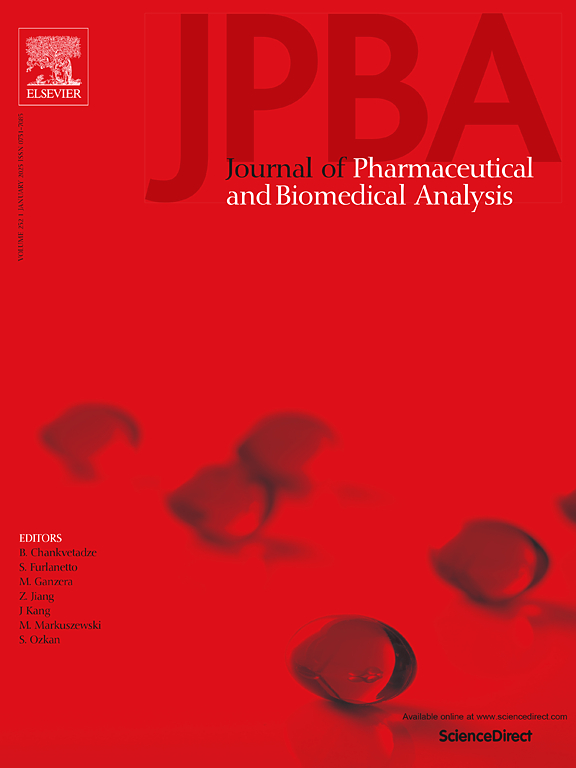Dispersive microextraction techniques as efficient strategies for the analysis of saliva: A comprehensive review
IF 3.1
3区 医学
Q2 CHEMISTRY, ANALYTICAL
Journal of pharmaceutical and biomedical analysis
Pub Date : 2024-12-18
DOI:10.1016/j.jpba.2024.116644
引用次数: 0
Abstract
This review article brings together two of the current hot-spots in the field of analytical chemistry, and more specifically in the sample preparation stage: the use of dispersive microextraction techniques, and the analysis of saliva. Due to saliva collection is minimally invasive, it is increasingly being considered in bioanalysis. Moreover, bioanalysis is routine and agglutinates a high number of samples demanding for fast results, thus high-throughput assays are highly required. On the other hand, if something characterizes biological matrices, including saliva, is their complex composition. To adapt the matrix to the analytical method to be applied and to avoid as far as possible the matrix effect, an efficient sample preparation stage is required. To this regard dispersive microextraction techniques, as rapid, efficient and sustainable sample preparation approaches, play a crucial role. In the first part of the review, different workflows for the collection and pretreatment will be briefly described, placing special emphasis on advice to follow. Then, a compilation of the different applications of dispersive techniques for the analysis of saliva is presented, in which the trends observed in both specific analytes and microextraction approaches used are discussed.
分散微萃取技术作为唾液分析的有效策略:综述。
这篇综述文章汇集了目前分析化学领域的两个热点,更具体地说,在样品制备阶段:分散微萃取技术的使用,以及唾液的分析。由于唾液收集是微创的,它越来越多地被认为是生物分析。此外,生物分析是常规的,并且需要大量的样品,需要快速的结果,因此高度需要高通量的分析。另一方面,生物基质(包括唾液)的特征是其复杂的组成。为了使基体适应所采用的分析方法,并尽可能地避免基体效应,需要一个高效的样品制备阶段。在这方面,分散微萃取技术作为一种快速、高效和可持续的样品制备方法,发挥着至关重要的作用。在回顾的第一部分中,将简要描述收集和预处理的不同工作流程,并特别强调要遵循的建议。然后,介绍了分散技术在唾液分析中的不同应用的汇编,其中讨论了在特定分析物和微萃取方法中观察到的趋势。
本文章由计算机程序翻译,如有差异,请以英文原文为准。
求助全文
约1分钟内获得全文
求助全文
来源期刊
CiteScore
6.70
自引率
5.90%
发文量
588
审稿时长
37 days
期刊介绍:
This journal is an international medium directed towards the needs of academic, clinical, government and industrial analysis by publishing original research reports and critical reviews on pharmaceutical and biomedical analysis. It covers the interdisciplinary aspects of analysis in the pharmaceutical, biomedical and clinical sciences, including developments in analytical methodology, instrumentation, computation and interpretation. Submissions on novel applications focusing on drug purity and stability studies, pharmacokinetics, therapeutic monitoring, metabolic profiling; drug-related aspects of analytical biochemistry and forensic toxicology; quality assurance in the pharmaceutical industry are also welcome.
Studies from areas of well established and poorly selective methods, such as UV-VIS spectrophotometry (including derivative and multi-wavelength measurements), basic electroanalytical (potentiometric, polarographic and voltammetric) methods, fluorimetry, flow-injection analysis, etc. are accepted for publication in exceptional cases only, if a unique and substantial advantage over presently known systems is demonstrated. The same applies to the assay of simple drug formulations by any kind of methods and the determination of drugs in biological samples based merely on spiked samples. Drug purity/stability studies should contain information on the structure elucidation of the impurities/degradants.

 求助内容:
求助内容: 应助结果提醒方式:
应助结果提醒方式:


